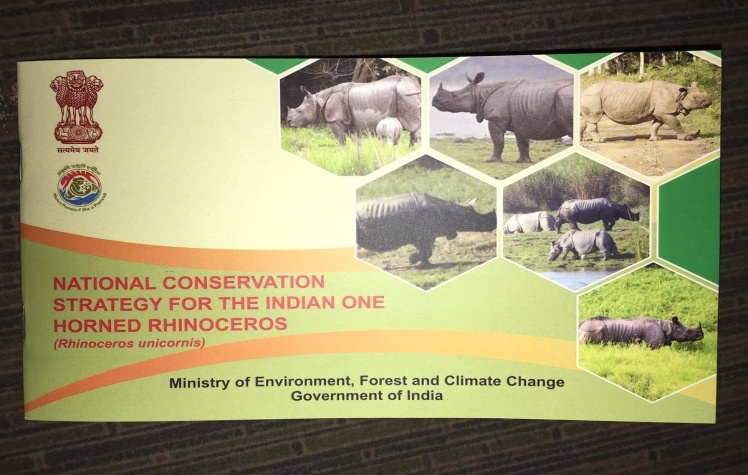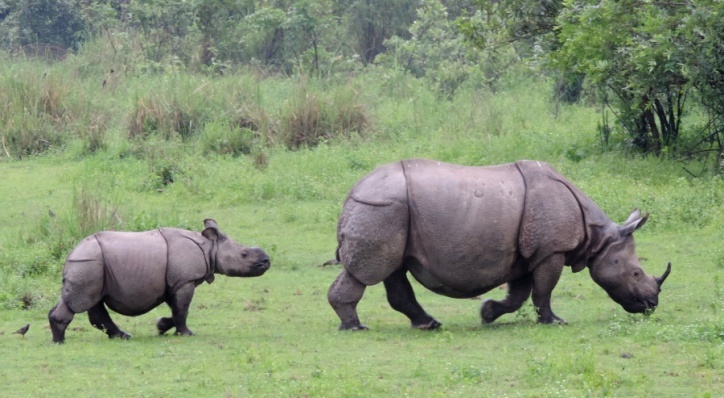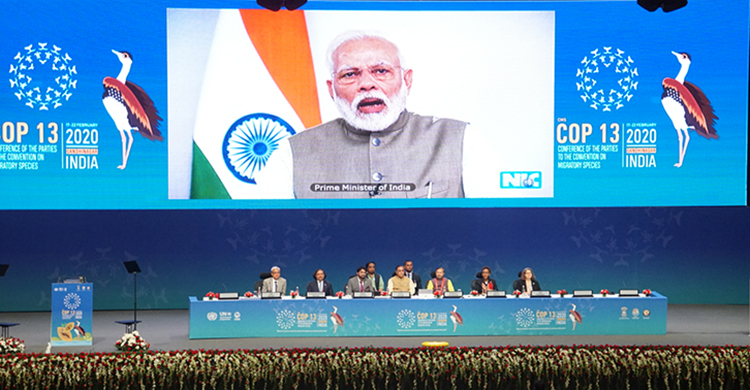Introduction
Introduction
The Wildlife Division of the Ministry of Environment, Forest and Climate Change, Government of India is the nodal Division which deals with the policy, legal and finances for the conservation of wildlife in the Country. The Wildlife Wing is headed by the Additional Director General of Forests (Wildlife) who is also designated as the Director, Wildlife Preservation under the Wild Life (Protection) Act, 1972. The Division also provides financial support to the State/ UT Governments for conservation of wildlife and their habitats through the Centrally Sponsored Scheme – Development of Wildlife Habitats (CSS-DWH).
Centrally Sponsored Scheme CSS – Integrated Development of Wildlife Habitats:
The main intention underlying the declaration of the PAs was to maintain the ecological viability of the wildlife rich forested areas. At present India has a network of 987 Protected Areas (106 National Parks, 564 Wildlife Sanctuaries, 99 Conservation Reserves and 218 Community Reserves). The details of the Protected Areas in India may be seen at
http://www.wiienvis.nic.in/Database/Protected_Area_854.aspx
The Government of India provides financial and technical assistance to the State/UT Governments for activities aimed at wildlife conservation through the Centrally Sponsored Scheme viz. ‘Integrated Development of Wildlife Habitats’. The scheme has following three components:
i. Support to Protected Areas (National Parks, Wildlife Sanctuaries, Conservation Reserves and Community Reserves)
ii. Protection of Wildlife Outside Protected Areas and mitigation of Human Wildlife conflict.
iii. Recovery programmes for saving critically endangered species and habitats.
Pattern of Funding:
100% central assistance is provided for non-recurring items and 50% assistance for recurring items.
Areas falling in mountain regions, coastal zones, deserts, or those areas which support certain selected endangered species, are eligible for 100% central assistance for both recurring and non-recurring items.
- Support to Protected Areas:
Eligible PAs: National Parks, Wildlife Sanctuaries, Conservation Reserves and Community Reserves, other than those availing central assistance under the CSS- Project Tiger, which are duly notified under the Wild Life (Protection) Act, 1972 and are under the control of the Chief Wildlife Wardens.
- Protection of Wildlife Outside Protected Areas:
There is substantial wildlife and natural resources lying outside the Protected Areas network of India. This component seeks to support the conservation of wildlife in these areas.
Eligible Areas:
High value biodiversity areas outside PAs. Areas contiguous to PAs/corridors are given priority.
The Chief Wild Life Wardens prepare a Biodiversity Conservation Plan for such selected area; Human-wildlife conflict management in and around forests.
Pattern of Funding: Same as in the case of PAs.
- Recovery Programme for Critically Endangered Species and Habitats:
There are currently 22 critically endangered species in the country which are covered under this component. These are Snow Leopard, Bustard (including Floricans), Dolphin, Hangul, Nilgiri Tahr, Marine Turtles, Dugongs, Edible Nest Swiftlet, Asian Wild Buffalo, Nicobar Megapode, Manipur Brow-antlered Deer, Vultures, Malabar Civet, Indian Rhinoceros, Asiatic Lion, Swamp Deer, Jerdon’s Courser, Northern River Terrapin, Clouded Leopard, Arabian Sea Humpback Whale, Red Panda and Caracal. The Director, Wildlife Preservation, Government of India, in consultation with the Wildlife Institute of India or the relevant scientific institute and with the approval of the Standing Committee of the National Board for Wild Life can initiate other recovery programmes or wind up an ongoing programme.
Pattern of Funding:
100% assistance is provided for both non-recurring and recurring items.
Each recovery programme has to be based on a comprehensive and scientific ‘Recovery Plan’. The Chief Wild Life Wardens of the concerned States (if the species range is in more than one State), shall jointly prepare the Recovery Plan with the help of a national scientific institute/organization of repute.
Activities under CSS- ‘Integrated Development of Wildlife Habitats’:
Activities covered under the Centrally Sponsored Scheme ‘Integrated Development of Wildlife Habitats’ are as follows:
1. Management Planning and Capacity Building:
i. Strengthening wildlife research, education and nature awareness
ii. Staff development and capacity building
iii.Monitoring and evaluation<
iv. Management Planning
2. Anti-Poaching & Infrastructure Development:
i. Anti-poaching activities
ii. Strengthening of infrastructure
iii. Strengthening Wildlife veterinary care
iv. Strengthening Staff welfare activities
3. Restoration of habitats:
i. Habitat Improvement Activities
ii. Safeguards / Retrofitting measures
4. Eco-Development and Community Oriented Activities:
i. Addressing man-animal conflict
ii. Strengthening co-existence agenda
iii. Deciding inviolate spaces and relocation of villages from crucial wildlife habitats
iv. Fostering ecotourism
v. Assistance to activities in Trans-boundary Protected Areas
Financial Releases Made During the Last Five Years- State/UT-Wise under CSS- ‘Integrated Development of Wildlife Habitats’
(Rs. in lakhs)
| S.No |
State/UT
|
2016-17
|
2017-18
|
2018-19
|
2019-20
|
2020-21
|
|---|---|---|---|---|---|---|
|
1
|
A& N Islands |
118.49
|
0
|
191.00
|
132.64
|
00
|
|
2
|
Andhra Pradesh |
0
|
480.75
|
75.00
|
0
|
0
|
|
3
|
Arunachal Pradesh |
256.8107
|
269.93
|
344.42
|
512.69
|
312.5865
|
|
4
|
Assam |
0
|
275.82
|
265.32
|
164.26
|
0
|
|
5
|
Bihar |
100.576
|
322.67
|
749.00
|
148.142
|
205.1644
|
|
6
|
Chandigarh |
26.06514
|
0
|
0
|
0
|
25.16
|
|
7
|
Chhattisgarh |
278.9453
|
435.01
|
350.61
|
310.0318
|
104.35936
|
|
8
|
Goa |
0
|
85.99
|
0
|
111.654
|
0
|
|
9
|
Gujarat |
497.604
|
558.52
|
2232.00
|
0
|
124.5849
|
|
10
|
Haryana |
124.6572
|
181.44
|
155.00
|
237.6078
|
18.2212
|
|
11
|
Himachal Pradesh |
280.31
|
237.41
|
370.30
|
375.76554
|
187.63518
|
|
12
|
Jammu & Kashmir |
336.50626
|
577.91
|
492.43
|
0
|
80.62863
|
|
13
|
Jharkhand |
0
|
95.60
|
50.51
|
93.96
|
198.2265
|
|
14
|
Karnataka |
325.52
|
427.89
|
653.00
|
739.046
|
586.126341
|
|
15
|
Kerala |
1928.42
|
900.83
|
1293.40
|
845.026
|
731.2845
|
|
16
|
Madhya Pradesh |
322.265
|
1379.48
|
912.20
|
629.266
|
801.60127
|
|
17
|
Maharashtra |
497.35
|
1050.18
|
1031.20
|
715.781
|
146.08135
|
|
18
|
Manipur |
340.032
|
425.66
|
405.60
|
396.455
|
241.11948
|
|
19
|
Meghalaya |
55.23
|
199.38
|
312.00
|
238.839
|
263.50463
|
|
20
|
Mizoram |
1234.95
|
487.14
|
430.00
|
431.79
|
339.60855
|
|
21
|
Nagaland |
357.846
|
565.87
|
882.20
|
953.69
|
260.00105
|
|
22
|
Odisha |
279.65
|
342.93
|
499.00
|
701.504
|
694.18819
|
|
23
|
Puducherry |
00
|
00
|
00
|
00
|
12.00
|
|
24
|
Rajasthan |
453.87878
|
622.4216
|
585.00
|
741.315
|
309.12634
|
|
25
|
Sikkim |
145.52
|
202.154
|
394.00
|
557.355
|
349.623
|
|
26
|
Tamil Nadu |
0
|
394.7252
|
384.10
|
409.505
|
334.0354
|
|
27
|
Telangana |
0
|
157.0853
|
0
|
0
|
36.59304
|
|
28
|
Tripura |
0
|
0
|
0
|
90.317
|
260.679
|
|
29
|
Uttar Pradesh |
250.956
|
386.10
|
119.81
|
426.251
|
312.9244
|
|
30
|
Uttarakhand |
545.30576
|
3200.3618
|
1764.10
|
1401.19
|
441.61031
|
|
31
|
West Bengal |
237.66
|
657.9924
|
960.60
|
891.073
|
710.61953
|
|
32
|
Puducherry |
0
|
0
|
0
|
0
|
0
|
|
33
|
Lakshadweep |
0
|
6.71
|
46.30
|
193.272
|
462.859
|
|
34
|
Delhi |
0
|
0
|
551.90
|
0
|
0
|
|
35
|
Ladakh UT |
0
|
0
|
0
|
0
|
223.17292
|
| TOTAL |
8994.54814
|
14927.9603
|
16500.00
|
12448.42614
|
8761.324971
|
Management Effectiveness Evaluation (MEE) of the CSS- Integrated Development of Wildlife Habitats:
Wildlife Division (MoEFCC) with the support from Wildlife Institute of India, completed one cycle Management Effectiveness Evaluation of all National Parks and Wildlife Sanctuaries in the country in four phases from 2006 to 2019 under CSS- Integrated Development of Wildlife Habitats- Assistance for Development of National Parks and Sanctuaries.
The study shows significant outcomes. The overall MEE Score is 60.56% ranging from 93.33% to 26.67%. The 12% parks in ‘Very Good’ category, followed by 40% in ‘Good’ category, 43 % in ‘Fair’ category and 5% in ‘Poor’ Category. Gir National Park (Gujarat) recorded highest MEE Score of 93.33% rated in ‘Very Good’ category and Turtle Wildlife Sanctuary (Uttar Pradesh) record the lowest MEE score with 26.67% rated in ‘Poor’ category. The detailed information on MEE is available in WII website (https://www.wii.gov.in).
|
Total No. of PAs
|
Overall MEE Score (%)
|
Evaluation Category
|
|||
|---|---|---|---|---|---|
|
442
|
60.56%
|
Very Good
|
Good
|
Fair
|
Poor
|
|
12%
|
40%
|
43%
|
5%
|
||
During the year, 2015-16, it is proposed to evaluate 40 more PAs. Proposal in this regard is under process.
Species Recovery Programme:
Out of 22 species identified for the species recovery programme, financial assistance has been provided for nine species as per the requests received from the States/ Union Territories. The amount provided to the State/Union Territory in respect of these species is as below:
|
Name of Species
|
Name of State
|
Year
|
Amount Released
(Rs. in lakh)
|
|---|---|---|---|
|
Hangul
|
Jammu & Kashmir
|
2008-09
|
99.00
|
|
Jammu & Kashmir
|
2010-11
|
89.62
|
|
|
Jammu & Kashmir
|
2012-13
|
79.94
|
|
|
Total
|
268.56
|
||
|
Snow Leopard
|
Jammu & Kashmir
|
2008-09
|
126.00
|
|
Jammu & Kashmir
|
2010-11
|
43.20
|
|
|
Jammu & Kashmir
|
2017-18
|
386.505
|
|
|
Jammu & Kashmir
|
2018-19
|
149.84
|
|
|
Uttarakhand
|
2008-09
|
86.40
|
|
|
Uttarakhand
|
2016-17
|
62.955
|
|
|
Arunachal Pradesh
|
2009-10
|
3.20
|
|
|
Arunachal Pradesh
|
2019-20
|
98.57
|
|
|
Himachal Pradesh
|
2010-11
|
24.16
|
|
|
Himachal Pradesh
|
2011-12
|
69.048
|
|
|
Himachal Pradesh
|
2012-13
|
71.488
|
|
|
Himachal Pradesh
|
2013-14
|
10.15
|
|
|
Himachal Pradesh
|
2014-15
|
53.555
|
|
|
Himachal Pradesh
|
2015-16
|
33.96
|
|
|
Total
|
1219.031
|
||
|
Vulture
|
Punjab
|
2008-09
|
16.00
|
|
Punjab
|
2010-11
|
2.40
|
|
|
Haryana
|
2008-09
|
38.00
|
|
|
Haryana
|
2011-12
|
9.595
|
|
|
Haryana
|
2015-16
|
99.33
|
|
|
Haryana
|
2016-17
|
116.0472
|
|
|
Haryana
|
2017-18
|
181.4448
|
|
|
Haryana
|
2018-19
|
122.304
|
|
|
Haryana
|
2019-20
|
193.74
|
|
|
Gujarat
|
2008-09
|
12.30
|
|
|
Kerala
|
2015-16
|
24.00
|
|
|
Kerala
|
2016-17
|
16.58
|
|
|
Kerala
|
2017-18
|
25.498
|
|
|
Kerala
|
2018-19
|
25.498
|
|
|
Karanataka
|
2019-20
|
130.8576
|
|
|
Uttarakhand
|
2017-18
|
580.23
|
|
|
Tripura
|
2020-21
|
51.619
|
|
|
West Bengal
|
2017-18
|
79.44
|
|
|
West Bengal
|
2018-19
|
110.04
|
|
|
West Bengal
|
2019-20
|
142.35
|
|
|
West Bengal
|
2020-21
|
102.0063
|
|
|
Total
|
2079.2799
|
||
|
Swiftlets
|
Andaman & Nicobar Islands
|
2009-10
|
30.99
|
|
Andaman & Nicobar Island
|
2010-11
|
24.672
|
|
|
Andaman & Nicobar Island
|
2011-12
|
19.20
|
|
|
Andaman & Nicobar Island
|
2012-13
|
17.54
|
|
|
Andaman & Nicobar Islands
|
13.79
|
||
|
Total
|
106.192
|
||
|
Nilgiri Tahr
|
Tamil Nadu
|
2009-10
|
4.80
|
|
Kerala
|
2016-17
|
82.04
|
|
|
Kerala
|
2017-18
|
88.80
|
|
|
Kerala
|
2018-19
|
110.39
|
|
|
Kerala
|
2020-21
|
16.372
|
|
|
Total
|
302.402
|
||
|
Manipur Borw Antler Deer -Sanghai Deer
|
Manipur
|
2009-10
|
33.96
|
|
Manipur
|
2013-14
|
27.82
|
|
|
Manipur
|
2014-15
|
79.152
|
|
|
Manipur
|
2015-16
|
113.38
|
|
|
Manipur
|
2016-17
|
128.48
|
|
|
Manipur
|
2017-18
|
131.1624
|
|
|
Manipur
|
2018-19
|
124.71
|
|
|
Manipur
|
2019-20
|
123.86
|
|
|
Manipur
|
2020-21
|
66.34848
|
|
|
Total
|
828.87288
|
||
|
Asiatic Lion
|
Gujarat
|
2010-11
|
674.541
|
|
Gujarat
|
2011-12
|
675.859
|
|
|
Gujarat
|
2018-19
|
1702.62
|
|
|
Total
|
3053.020
|
||
|
Dugong
|
Andaman & Nicobar Island
|
2013-14
|
18.61
|
|
Andaman & Nicobar Islands
|
2013-14
|
36.93
|
|
|
Andaman & Nicobar Islands
|
2016-17
|
27.87
|
|
|
Total
|
83.41
|
||
|
Wild buffalo
|
Chhattisgarh
|
2012-13
|
13.75
|
|
Chhattisgarh
|
2013-14
|
95.17
|
|
|
Chhattisgarh
|
2014-15
|
101.12
|
|
|
Chhattisgarh
|
2017-18
|
152.298
|
|
|
Total
|
362.338
|
||
|
Jerdon’s Courser
|
Andhra Pradesh
|
2014-15
|
63.31
|
|
Total
|
63.31
|
||
|
Great Indian Bustard
|
Maharashtra
|
2015-16
|
110.63
|
|
Maharashtra
|
2016-17
|
135.85
|
|
|
Maharashtra
|
2017-18
|
85.32
|
|
|
Maharashtra
|
2018-19
|
134.08569
|
|
|
Maharashtra
|
2019-20
|
60.35846
|
|
|
Maharashtra
|
2020-21
|
36.8324
|
|
|
Rajasthan
|
2016-17
|
65.36
|
|
|
Rajasthan
|
2017-18
|
120.65
|
|
|
Rajasthan
|
2018-19
|
121.387
|
|
|
Rajasthan
|
2019-20
|
0
|
|
|
Rajasthan
|
2020-21
|
0
|
|
|
Karnataka
|
2019-20
|
82.58
|
|
|
Karnataka
|
2020-21
|
22.50984
|
|
|
Total
|
975.56339
|
||
|
Rhinoceros
|
West Bengal
|
2017-18
|
107.861
|
|
West Bengal
|
2018-19
|
40.43585
|
|
|
West Bengal
|
2019-20
|
20.65515
|
|
|
Uttarakhand
|
2017-18
|
300.60
|
|
|
Total
|
469.552
|
||
|
Dolphin
|
Bihar
|
2017-18
|
6.79
|
|
Bihar
|
2018-19
|
100.33
|
|
|
Bihar
|
2020-21
|
21.685
|
|
|
Odisha
|
2019-20
|
23.40
|
|
|
Odisha
|
2020-21
|
11.40
|
|
|
Lakshadweep
|
2019-20
|
85.872
|
|
|
Lakshadweep
|
2020-21
|
34.25
|
|
|
Total
|
283.727
|
||
|
Fresh water Marine /Olive turtle
|
Bihar
|
2017-18
|
23.2465
|
|
Odisha
|
2019-20
|
134.54164
|
|
|
Odisha
|
2020-21
|
62.04919
|
|
|
Lakshadweep
|
2019-20
|
56.48
|
|
|
Lakshadweep
|
2020-21
|
34.25
|
|
|
Goa
|
2017-18
|
30.72
|
|
|
Total
|
341.28733
|
||
|
Red Panda
|
West Bengal
|
2018-19
|
54.38
|
|
West Bengal
|
2019-20
|
90.46266
|
|
|
West Bengal
|
2020-21
|
40.94635
|
|
|
Total
|
185.78901
|
||
|
Batagur Baska
|
West Bengal
|
2019-20
|
139.04
|
|
Total
|
139.04
|
||
|
Humpback Whale
|
Kerala
|
2020-21
|
13.65
|
|
Lakshadweep
|
2020-21
|
33.31
|
|
|
Total
|
46.96
|
||
|
Bengal Florican
|
Arunachal Pradesh
|
2020-21
|
45.225
|
|
Total
|
45.225
|
||
|
Clouded Leopard
|
Meghalaya
|
2020-21
|
101.4704
|
|
Total
|
101.4704
|
||
|
S.No.
|
State Name
|
Year
|
Village
|
Families
|
Amount released(Rs. in lakh)
|
|---|---|---|---|---|---|
|
1
|
Kerala
|
2011-12
|
Gollour
|
55 Settlement
|
350.00
|
|
2012-13
|
Amnavayal
|
55 Settlement
|
200.00
|
||
|
2013-14
|
Kottankara
|
63 Settlement
|
784.00
|
||
|
2014-15
|
Kurchiyat
|
105 Settlement
|
446.00
|
||
|
2015-16
|
105 Settlement
|
270.00
|
|||
|
2016-17
|
Chettiyalathur
|
231 families
|
1108.80
|
||
|
2
|
Mizoram
|
2010-11
|
Dumpui’s village
|
61 families
|
448.00
|
|
2013-14
|
Dumpui’s
|
61 families
|
122.00
|
||
|
3
|
Mizoram
|
2016-17
|
Kawanpui West (45 families) Darangawn West (100 families) Thorangthlang Wildlife Sanctuary 145 families
|
145 families
|
1044.00
|
|
2017-18
|
145 families
|
261.00
|
|||
|
4
|
Madhya Pradesh
|
2017-18
|
156 families for Jaitpur village inside Ratapani WLS
|
156 families
|
748.80
|
Human-Animal Conflict:
In India, human-animal conflict is seen across the country in a variety of forms, including monkey menace in the urban centers, crop raiding by ungulates and wild pigs, depredation by elephants, cattle lifting and human death and injury by tigers, leopards and other wild animals. Human-animal conflict occurs both inside Protected Areas as well as outside Protected Areas. The intensity of the conflict is generally more in areas outside Protected Area network than inside.
Recently the incident of human-animal conflict has increased considerably. The increase is due to various reasons. Important among them are increase in wild animal population, fragmentation of habitats, non availability of food and water in the habitat due to degradation, disturbance in the corridors due to developmental activities, change in cropping pattern, increase in human populations etc. Various other reasons include adaptability of certain animals like leopard, monkey, nilgai, bear etc which allow them to live successfully close to human habitation.
The human-animal conflict is an important part of wildlife management as the co-operation of local population depends largely on winning their support by reducing loss to them by wild animals among many others.
In order to mitigate the human animal conflict, a national workshop on ‘Developing Strategies for Mitigation of Human wildlife conflict’ was held on 20.8.2013 at New Delhi wherein the matter was discussed and several mitigating measures were suggested. Some of the steps taken by the Government to manage and mitigate human-animal conflict are as follows:
i. This Ministry vide O.M. No. 1-52/2014-WL-I dated 24th December, 2014 had issued an Advisory in the context of human-wildlife conflict wherein the States have been requested to take pro-active steps including exercise of powers under the Wild Life (Protection) Act, 1972 for mitigation of human-wildlife conflict. Ministry has also issued a detailed advisory on 1st June, 2015 to the State/Union Territory Governments on the priority actions for management of human wildlife conflict.
ii. Further, the Ministry has issued an Advisory to deal with Human wildlife conflict to States/UTs on 06.02.2021. The Advisory recommends coordinated interdepartmental action, identification of conflict hot spots, adherence to Standard Operating Procedures, establishment of rapid response teams, formation of State and District level committees to review the quantum of ex-gratia relief, issuing guidance/instructions for expedited payments, and provision of adequate funds for suitable portion of ex-gratia relief to be paid within 24 hours to the affected persons in the case of death and injury to persons.
iii. Wildlife Institute of India, in consultation with the Ministry of Environment Forest & Climate Change, National Highway Authority of India, National Tiger Conservation Authority and World Bank Group, has published guidelines on eco-friendly measures to mitigate the impacts of linear infrastructure to assist project agencies in designing linear infrastructure, including electric transmission lines.
iv. Financial assistance is provided by the Ministry to States/Union Territories under the Centrally Sponsored Schemes of Development of Wildlife Habitats, Project Tiger and Project Elephant for activities like creation and maintenance of water holes for wild animals in Protected Areas, soil and moisture conservation measures, establishment of anti-poaching camps, strengthening wildlife veterinary care, eradication of weeds, creation and maintenance of fire lines, deployment of Tiger Protection Force and special Tiger Protection Force etc.
v. A network of Protected Areas viz., National Parks, Sanctuaries, Conservation Reserves and Community Reserves covering important wildlife habitats has been created all over the country under the provisions of the Wild Life (Protection) Act, 1972 to conserve wild animals and their habitats.
vi. Construction/erecting of physical barriers such as solar powered electric fence, bio-fencing using cactus, boundary wall etc. to prevent the entry of wild animals into crop field.
vii. Awareness campaigns to sensitize, guide and advise the general public on man-conflict.
• Indo-German Technical Cooperation project on Human Wildlife Conflict Mitigation in India:
India’s National Human-Wildlife Conflict Mitigation Strategy and Action Plan (HWC-NAP) and 4 supplementary frameworks were released by Shri Ashwini Kumar Choubey, Hon’ble Minister of State, MoEFCC on 8th October, 2021 in New Delhi. HWC-NAP and supplementary frameworks have been developed by the MoEFCC with support from GIZ and WII, under the Indo-German Technical Cooperation Project on Human-Wildlife Conflict Mitigation in India. The common frameworks for developing state-level and division-level plans are being used to develop state plans for Karnataka, Uttarakhand and West Bengal and division-level plans for project pilot sites, to ensure alignment between national planning and field implementation.
• Greater One-horned Rhinoceros:
The Greater One-horned Rhinoceros (Rhinoceros unicornis) once ranged across the entire northern part of Indian subcontinent, along the Indus, Ganges and Brahmaputra River basins, from Western Indian border to the Indo-Myammar border. Presently, the species is found in the wild in three states of Assam, Uttar Pradesh and West Bengal. The Government of India has taken several initiatives for protection of Rhinoceros and its habitat. With a view to strengthen the rhino conservation efforts, the Ministry of Environment, Forest and Climate Change has launched the “National Conservation Strategy for the Greater One-Horned Rhinoceros” in February 2019.Augmenting the Rhino population in erstwhile Rhino areas; strengthening the existing conservation efforts through scientific and administrative measures; better transboundary cooperation, etc. are envisioned in the strategy. This initiative is in lines with the “New Delhi Declaration”, adopted during the Rhino Range States meeting.


• Hosting of 13th Conference of Parties to the Convention on Migratory Species:
The Government of India successfully hosted the 13th Conference of the Parties to the Convention on the Conservation of Migratory Species of Wild Animals (CMS COP13), during 17th- 22ndFebruary, 2020 at Gandhinagar, Gujarat which was attended by representatives from several countries besides Heads of various biodiversity related Inter-Governmental Organizations. A “Gandhinagar Declaration” was adopted during the COP which envisages “Connectivity” amongst landscapes, habitats, amongst the various conventions and also between the people and ecosystems for ensuring better conservation of migratory species across the globe. The hosting of the COP has enabled India to prove as a true global leader. The CMS COP Presidency for the next three years will usher India in playing a very important role in Marine conservation including conservation of marine species. India would also be playing a leadership role and would be the nerve centre for conservation of migratory birds along the Central Asian Flyway (CAF) by establishing a common platform for institutionalizing the migratory bird conservation along the CAF. The CMS COP Presidency would enable India to enhance its cooperation with CMS countries for conservation of migratory species and also in developing linkage with Non CMS countries under SAARC (Nepal, Bhutan), ASEAN and EAS countries

• Advisory on Exotic animals:
In India, several species are listed in the Wild Life (protection) Act, 1972 and are protected. However, exotic species are imported to India and bred in captivity without proper registration. Considering this, the Ministry had issued an Advisory in June, 2020 for Voluntary Disclosure of Exotic Live Species, with the objectives of creating a unified information system of the stock of exotic live species at the State/Central level through voluntary disclosure and the use of that database towards controlling and management of zoonotic diseases, and for facilitating better management of the species and providing guidance to their holders for their proper care and well-being. The entire registration process has been made through a hassle free online system for the benefit of the importers and owners of exotic live animals as well as for the concerned authorities. This effort of the Ministry has also been lauded by the Hon’ble Apex Court of India. Ministry is contemplating to widening the scope of the advisory to include non CITES listed exotic species also.
• Considering the need to have a conservation paradigm for marine mega fauna and marine turtles, the Ministry released ‘Marine Mega Fauna Stranding Guidelines’ and ‘National Marine Turtle Action Plan (2021-2026)’ in January 2021. These documents not only promote inter-sectoral action for conservation but also guide improved coordination amongst the government, civil society and all relevant stakeholders on the response to cases of stranding, entanglement, injury or mortality of marine mammals and also conservation of marine turtles.


• Action Plan for Vulture Conservation in India (2020-2025):
The Ministry launched the five-year Action Plan for Vulture Conservation in India (2020-2025) in November, 2020. The Action Plan has identified priority actions for the conservation of vultures and their habitats. It also advocates prevention of misuse of veterinary non-steroidal anti-inflammatory drugs and awareness of the importance of conservation of vultures. The other important objectives of the Action Plan are to institute a system, which automatically removes a drug from veterinary use if it is found to be toxic to vultures, establishment of additional Vulture Conservation.

Breeding Centres (VCBCs), Vulture safe zones in every State and establishment of dedicated vulture rescue centres in the country. At present, the focus was on conservation of Gyps species of vultures, but now, the conservation breeding programmes of Red Headed Vultures and Egyptian Vultures would be also initiated. The APVC (2020-2025) will also draw expertise and advice, from the existing Regional Steering Committee (RSC) for Coordination with various countries in South Asia which are within the distribution range of the vultures, as well as from SAVE, a consortium of NGOs and International Conservation Organizations which are actively working towards conservation of South Asian Vultures.
• Wildlife Week, 2021 celebrations:
To instill the conservation ethos amongst the general public, Shri Narendra Modi, Hon’ble Prime Minister of India delivered a message on the occasion of Wildlife Week, 2021.
On the occasion of Wildlife Week, 2021 (2nd-08th October 2021), Gandhi Jayanti and heralding the Iconic Week of Azadi ka Amrit Mahotsav of MoEFCC, Shri Bhupender Yadav, Hon’ble Minister for EF&CC, along with Shri Ashwini Kumar Chaubey, Hon’ble Minister of State, EF&CC and other senior officials of the Ministry flagged off a rally on wheels ‘India for Tigers’ on 2nd October, 2021. Activities like painting competition, webinars, documentaries, wildlife photography competition, etc. aiming at generating awareness amongst the people, especially students were taken up during the entire week in the country through hybrid mode, following the COVID protocols.
• Release of Guidelines for Sustainable Ecotourism in forest and wildlife areas 2021:
The Ministry released the ‘Guidelines for sustainable Ecotourism in the forest and wildlife areas-2021’ on 2nd October, 2021. These guidelines are applicable to ecotourism sites falling in forest, wildlife areas and eco-sensitive zone. Considering the need for a participatory approach for conservation of wildlife and its habitats, the guidelines emphasizes the engagement of local communities in a manner that enriches local economies and encourage sustainable use of indigenous material though financial viable value chains to help local communities become ‘Atma Nirbhar’ and promotes partnership among stakeholders in development of ecotourism as well as equitable sharing of benefits with local communities. Creation of foundation in each Protected Area and sharing of revenue with local communities has also been underscored in the guidelines.
• Release of field guide for monitoring Ganges and Indus river dolphins, associated aquatic fauna and habitat:
Dolphin is an aquatic apex predator and controls the aquatic system. Dolphin act as an umbrella species, whose conservation will result in wellbeing of associated habitat and biodiversity, including humans. Dolphin enumeration is very important to delineate important conservation areas, where development can be planned with appropriate mitigation measures, and to also secure livelihoods of local communities. So far, there was no synchronized enumeration plan, however sporadic enumerations have been done in past. First time a standardized monitoring protocol has been developed and was released in October, 2021. This would be employed for synchronized Dolphin enumeration exercise to be undertaken in states of Assam, West Bengal, Bihar, Jharkhand, Uttar Pradesh, Madhya Pradesh, Rajasthan and Punjab. Dolphin estimation is an important process and constituent of “Project Dolphin”
















